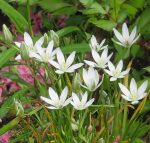 This perennial bulb goes by many common names including bird’s milk, grass lily, nap-at-noon, summer snowflake, starflower, and ten-o’clock lady. It is native to damp habitats in Europe, northern Africa, and the Middle East and is a member of the asparagus family, Asparagaceae, that also includes lily of the valley, hosta, and yucca. Plants grow 6-12″ tall and have a basal clump of 6-10 grass-like leaves 6-12″ long. The leaves begin to fade when leafless flower stems appear bearing terminal umbels of 10-20 6 star like flowers from late spring to early summer. Each flat, star-shaped flower is up to 3/4″ wide and has 6 lanceolate tepals that are white and striped green on the outside. Flowers open from noon to about sunset and are closed on cloudy days. Plants are vigorous and are considered noxious weeds in some areas but are cultivated as ornamental plants and are especially attractive in informal settings such as meadows and woodland meadow garden. The genus name Ornithogalum, comes from the Greek words ornis meaning bird, and gala meaning milk and refers to the white flowers. The specific epithet, umbrellatum, is from the classical Latin word umbrella, meaning umbrella, and refers to the umbrella-like shape of the inflorescence.
This perennial bulb goes by many common names including bird’s milk, grass lily, nap-at-noon, summer snowflake, starflower, and ten-o’clock lady. It is native to damp habitats in Europe, northern Africa, and the Middle East and is a member of the asparagus family, Asparagaceae, that also includes lily of the valley, hosta, and yucca. Plants grow 6-12″ tall and have a basal clump of 6-10 grass-like leaves 6-12″ long. The leaves begin to fade when leafless flower stems appear bearing terminal umbels of 10-20 6 star like flowers from late spring to early summer. Each flat, star-shaped flower is up to 3/4″ wide and has 6 lanceolate tepals that are white and striped green on the outside. Flowers open from noon to about sunset and are closed on cloudy days. Plants are vigorous and are considered noxious weeds in some areas but are cultivated as ornamental plants and are especially attractive in informal settings such as meadows and woodland meadow garden. The genus name Ornithogalum, comes from the Greek words ornis meaning bird, and gala meaning milk and refers to the white flowers. The specific epithet, umbrellatum, is from the classical Latin word umbrella, meaning umbrella, and refers to the umbrella-like shape of the inflorescence.
Type: Perennial bulb
Bloom: Umbels of star-shaped flowers with 6 white tepals striped with green on the outside from late spring to early summer
Size: 6-12″ H x 1-2′ W
Light:Full sun to part shade
Soil: Fertile, moderately moist, well-drained; somewhat drought tolerant when established; can not tolerate late summer rain
Hardiness: Zones 4-9
Care: Low maintance
Pests and Diseases: Bulb rot
Propagation: Offsets
Companion Plants: Virginia bluebell, lily of the valley, azalea
Photo Credit:Wikipedia